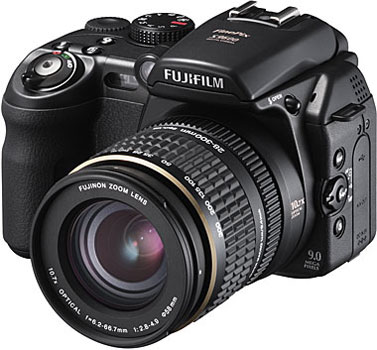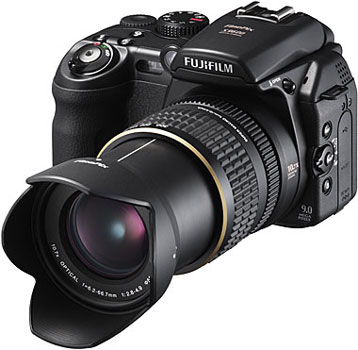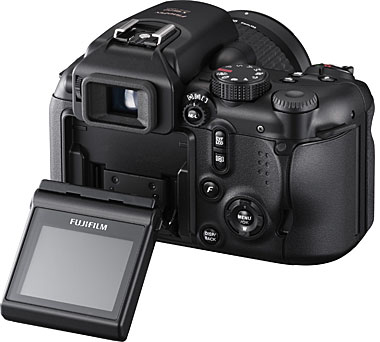
Sponsored by BoysStuff.co.uk
Fuji S9600
By Ian Urie
Sadly,
I have to report that my Finepix F11 has went walkabout.
I loved that little camera and took many pictures, but everything must end,
I suppose.
The story behind it is my daughter took it to France with her, and it vanished
on the trip.
So, with heavy heart (and much parental disapproval of my daughter), I started
looking around for another camera.
This time, I've decided to try out what is commonly known as a "bridge" camera.
The "bridge" referred to is the difference between a digital SLR and a compact
digital camera.
Looking below you might be forgiven in thinking the 9600 is a SLR.

It isn't, but it is a helluva camera!
I fell in love with the looks of this camera at first sight.
It looks like a camera used by someone
that knows about taking pictures.
It isn't, of course, cos it's mine.

One of the main differences between this and a SLR is the
lens.
Another main difference would be the price.
A full digital Fuji SLR like the S5 PRO is over £800 for the body (a lens
would boost it over the £1000),
and this camera came in around the same price as the F11 when it came out
(around £200)
Back to the lens, it isn't interchangeable, and is a permanent part of the
body.
This means you are less likely to get dust inside the camera, but also means
you can't spend all your hard earned cash on more lenses for it.
Right, let's have some quick facts taken from the blurb for the camera.
It's a 9 MP camera.
28-300mm equivalent lens
Can take up to 1600 ISO (similar to the F11)
10X optical zoom, 3X digital zoom
Dimensions: 128.0(W) X 93.0 (H) X 129.0(D) mm / 5.0(W) X 3.7(H)
X 5.1(D) in.
Weight: 650g / 22.9oz unloaded, Approx. 760g / 26.8oz (with
batteries and memory card loaded)
The camera takes two different storage formats, Compact Flash and Fuji's
XD. Separate slots are provided for each type of media.
The camera has a USB 2 interface.
What else?
Unlike the F11, you can't charge the camera using the USB slot, and power
for the camera is by means of 4 AA batteries.
Luckily you can use NI-MH rechargeables in it and the ones I've currently
got are 2500mAH, which gives me breathing space while taking pictures.
As you can see from the facts, it isn't a light little camera.
I've also bought a bag to keep the camera.
Lugging this about is sure to result in damage unless I'm using it at the
time.
The zoom isn't automatic but is extended by hand. Actually, I quite like this
feature.
I find it gives more control over the zoom.
The optical zoom is especially impressive even in panoramic mode.
Picture view is done on the 2 " LCD screen on the back which can be adjusted
by the tilt 'n' slide mount for it.
You can also take pictures using the viewfinder and switching off the LCD.
The camera can be used in full manual mode and using the myriad of controls
or selecting auto.
The camera saves pictures in either jpeg or CCD-RAW.
It also takes movies, at up to 30fps.
The movie feature is really impressive in that you can zoom while recording
which is something I didn't know could be accomplished.
It couldn't on any of my previous cameras.
Mind you, I've never had a camera that took 18mb to store a picture, either.
That's right, 18mb!!
This is in CCD-RAW format at max. resolution (why would you turn the resolution
down?)
CCD-RAW is the format used before the signal processor gets its paws on the
picture, this means you are actually saving at the 18mp quality of the lens.
Editing a picture that is saved in RAW is something else. Jpeg gets rid of
so much detail.
Because of the size of the pictures, I've loaded this camera with a 4gb compact
flash, which, so far, has managed to hold all the pictures I've taken with
it.

Here's the back view of the camera showing
most of the options on the camera.
The controls are reached easily while using the camera and the LCD/viewfinder
displays the option selected anyway.
Macro button is on the LHS of the camera and has two modes.
Macro and Super Macro.
Playing about with the camera (it hasn't been used in anger yet) reveals the
macro as simply stunning.
I'm looking forward to spring with this camera when I'll get out and about
with it.
The camera itself comes with a lens cover and a holder, and a shoulder strap,
as well as a lens hood shown in one of the pictures of the camera above.
Software is the usual Finepix viewer, with the addition of RAW file convertor,
Imagemixer for Finepix and VCD2 as well as their premium package
Hyper Utility.
Cables included are a USB lead and an A/V cable.
Time will tell how well this camera serves, but initial impressions are very
good.
Picture quality is outstanding so far, and battery life seems ok.
It will be a learning curve on how to get the best from the manual options,
but will , hopefully, stimulate the creative urge.
The only drawback , so far, is that there is no way I'll get allowed into
concerts with this camera, so I'll probably have to buy a compact as well.
| © RIYAN Productions |
